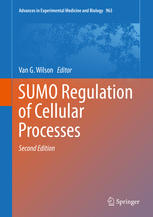

Most ebook files are in PDF format, so you can easily read them using various software such as Foxit Reader or directly on the Google Chrome browser.
Some ebook files are released by publishers in other formats such as .awz, .mobi, .epub, .fb2, etc. You may need to install specific software to read these formats on mobile/PC, such as Calibre.
Please read the tutorial at this link: https://ebookbell.com/faq
We offer FREE conversion to the popular formats you request; however, this may take some time. Therefore, right after payment, please email us, and we will try to provide the service as quickly as possible.
For some exceptional file formats or broken links (if any), please refrain from opening any disputes. Instead, email us first, and we will try to assist within a maximum of 6 hours.
EbookBell Team

4.4
72 reviewsThis is the second edition of a very well received book that details how the sumoylation system functions and how it modulates numerous cellular activities. SUMO is a post-translational modifier in the ubiquitin super-family that has gained recognition over the last twenty years as an essential and prevalent regulatory molecule.
Individual chapters explore the biochemistry, molecular biology, and cell biology of the sumoylation system and its substrate proteins.
The book is divided into three themed parts: Molecular Functions (I), Cell Growth Regulation (II), and Diseases (III). Parts I and II focus on the contribution of sumoylation to cellular activities in both the nuclear and cytoplasmic compartments. The nuclear activities covered include nucleic acid metabolism (both RNA and DNA), chromosome structure and replication, and nucleocytoplasmic transport. Cytoplasmic processes presented include regulation of membrane ion channels, general metabolism, and apoptotic signalling. Topics in Part III include the role of sumoylation in developmental abnormalities (craniofacial and cardiovascular), diabetes, neurodegenerative diseases, cancer, and infections with viruses and bacteria.
Each of the corresponding chapter authors is an active researcher who has made significant contributions to understanding sumoylation. This second edition provides updates and revisions to most of the original chapters plus adds six new chapters to address important developing areas of sumoylation research.
This volume is intended for a scientific audience from undergraduates to independent researchers. The content will serve as both a solid introduction for the novice reader and an in depth treatment for the advanced scholar.